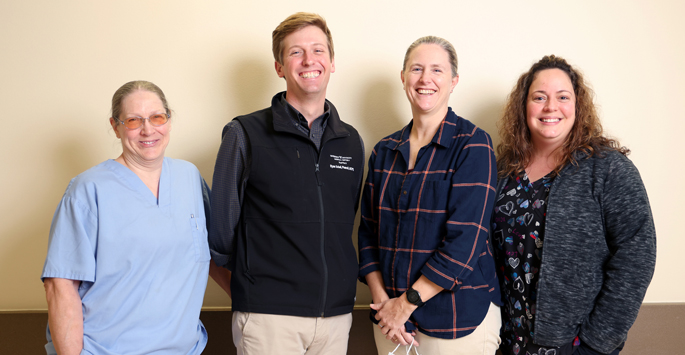
by Paul Govern
Vanderbilt University Medical Center recently became the nation’s second health care organization to receive The Joint Commission’s (TJC) Gold Seal of Approval for Parkinson’s Disease Certification.
A nonprofit organization better known for accrediting hospitals and other health care organizations, TJC, based in Oakbrook Terrace, Illinois, also offers more than 100 specialized certification programs based on various diseases and care delivery models. VUMC has so far elected to participate in four of these: ventricular assist device (for patients with weak or failing hearts), primary care medical home (a type of health care delivery model), advanced comprehensive stroke center (a collaborative certification from the American Heart Association/American Stroke Association and TJC), and now Parkinson’s disease.
Neurology Clinical Nurse Specialist Arlene Boudreaux, MSN, RN, instigated VUMC’s Parkinson’s certification effort. She says certification hinged in this case on complex efforts to personalize the timing of Parkinson’s inpatient medications at Vanderbilt University Hospital.
“There aren’t really defined criteria from The Joint Commission for Parkinson’s certification,” Boudreaux said. “While there’s a generic requirement that you improve patient satisfaction, you’re able to set your own clinical quality goals.”
A representative from TJC visited VUMC on Sept. 1 to review the Parkinson’s disease improvement program.
Parkinson’s patients, to best avoid tremor and gait disturbances, work with their neurologists to refine the timing of home medications, and their medication regimens can consequently become relatively complex and individualized.
As these patients happen to enter the hospital for various medical or surgical services, they enter environments where medications are administered according to standardized schedules. Divergence from individualized Parkinson’s medication regimens “can contribute to more delirium, more falls because of more tremors and gait disturbances, and increased inpatient mortality,” Boudreaux said.
The sole other organization certified by TJC for Parkinson’s disease is Hackensack University Medical Center in Hackensack, New Jersey, which earned the certification in 2019; when Hackensack’s certification came through, Boudreaux read about it.
“That’s what started it all. I looked at the data on our Parkinson’s patients and found we had the same problem they’d had in Hackensack.
“And because we are a massive hospital that tends to rely on standardized medication times, something as simple as ‘do it the way you do it at home’ took us a great deal of time to make happen.”
Boudreaux said VUH admits 350 to 400 patients per year with Parkinson’s; a great majority happen to be admitted to units other than neurology, and this was the target population for the improvement effort. In fall of 2020 a Parkinson’s Disease Quality Improvement Committee formed, with its core including Boudreaux; Ryan Schell, PharmD, manager of clinical operations, Department of Pharmaceutical Services; Fenna Phibbs, MD, MPH, associate professor of Neurology; Jessica Stroh, RN, movement disorders case manager; and Marie Glaser, MSN, RN, associate nursing officer, VUH. They were assisted by representatives from Health IT, the Department of Nursing Education and Professional Development, Vanderbilt Quality, Safety and Risk Prevention, and Enterprise Analytics. Boudreaux credits Schell and the Department of Pharmaceutical Services as having the biggest role in the improvement project.
Steps taken included:
- As Parkinson’s patients entered the hospital through the emergency department, pharmacists undertook to review their medications on a more regular basis.
- Pharmaceutical Services added staff who meet with patients entering the hospital to verify home medications.
- Education sessions were targeted to nurses and physicians across VUH.
- Notifications concerning timing of Parkinson’s medications were added to the electronic health record (EHR) system.
- Whenever an inpatient prescription appeared to vary from the timing of a patient’s individualized regimen, pharmacists received alerts, prompting them to enter the system to correct the timing of Parkinson’s medication administration.
- Automatic EHR alerts were added to discourage use of various drugs known to cause problems for patients with Parkinson’s.
Among other outcomes, the committee tracks observed-to-expected mortality, a patient severity-based metric involving a national benchmark for hospital admissions where Parkinson’s figures as a comorbidity.
In VUMC’s improvement project for Parkinson’s, comparing April through September of 2020 to July through September of 2022, the observed-to-expected mortality ratio in the target population at VUH (with 1.0 representing expected mortality) has decreased from 1.03 to 0.58.
“When I look at the numbers, we’re saving about eight lives a year, which may not sound like a lot,” Boudreaux said, “but if you come in here with Parkinson’s and you are terrified that somebody is going to mess up your world, that makes quite a difference.”
With reference to the same two periods, unexpected readmission to VUH within 30 days has decreased from 10.8% to 7.6% for the target population, and patient satisfaction has increased from 3.5 to 4.1 out of five.














